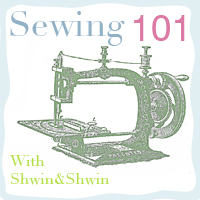First things first. The very first thing you need to know about sewing is the term “right sides together” I use it all the time. If you are brand new to sewing then you might not know what it means. It is just like it sounds however, fabric has a right side and a wrong side. As you can see in the picture above I have two pieces of fabric. Right sides together places both “right sides” of the fabric together face to face. The “wrong side is where you will sew.
Then creating a seam is sewing a straight edge along the side. The seam allowance is the side of the fabric from the edge to the stitch line. Different patterns have different seam allowances. That amount is how far over your stitch line should be. There are many different ways to finish your seams. You can obviously easily and quickly finish a seam with a serger by sewing the edge, or sewing a zig-zag stitch along the edge, however here are a few other ways of finishing the seams.
One is using pinking shears. They are scissors that cut a zig-zag or scalloped edge along the fabric. Doing this will help most fabrics not to fray or fray very little. It’s a quick and easy way to finish a seam.
Simply cut the edge close to the stitch line.
Then iron the seam flat. To do that press the flaps to both side. Ironing your seams as you sew is how you get the best most professional looking results. So become friends with your iron.
The next seam finish I will show you is a french seam. Intimidated? Don’t be. French seams are a great way to finish an edge in garments where you don’t want a raw edge at all. It will seem a little backwards but you start by placing the wrong sides together.
Take a narrower seam allowance than you would normally or than the pattern calls for. Sew along the right side.
Press your seam open. Then fold the seam so the right sides are together.
With the seam along the edge sew a new stitch line just past the seam allowance that is on the inside.
This encloses the raw edge so the seam on the back shows only the first seam and the new stitch line. Done.
Another seam finish is a bias bound seam. You would use this technique for exposed seams in a jacket, pants, or other garment of your choice. You can use store bought pre-packaged mini bias tape or you can make your own. Either way you want to notice that there are two flaps a larger side and a smaller side.
Once you have sewn your seam. (or you can do it all in one step but sewing the seam first is easier) Sandwich the bias tape around your seam. You want the larger side of the bias tape to be on the bottom side of what you are sewing.
Then sew a straight line along the edge of the bias tape.
Now you have a bias tape finished seam. Lovely right?
Ok the last seam finish is a great finish for a curved edge when you don’t want a lot of bulk, but some structure is desired. It is especially great for collars.
Start with your two pieces of fabric and place them right sides together.
Then using cording, (a lot like a small rope) Sew a wide zig-zag stitch over the cording follow the curve as you sew.
See the zig-zag stitch.
Next trim the excess fabric away from the stitched line.
Then turn it right side out and you will have a nice finished curve with the cording along the edge.






















mama marchand
So easy to understand! Thanks for this new feature. I'm taking a "get to know your sewing machine class" next month but already, I feel like I can do this just from this simple tutorial.<br /><br />Y'all rock!
Holymojo
This is great! Thank you for this new series!
Georgine
Thanks fir this series! It will be very useful for me!
Lauren Fisher
This is so awesome. Love back to the basics…love your blog!!
Gina
So my first visit to your blog was to check out the adorable cardigan you made for your little one and looking around I found this!! I am so excited and I feel that I understand more than not your explanations so my sewing machine might actually get out of the box! <br />Thank you!!
Amanda Webster
This is awesome information as I just need some refresher information.<br /><br />thanks,<br />Amanda
prettylittlethingsinabox
thank you for the lovely tutorial.. this is awesomeee… very helpful for newbies like myself.<br />cheers..
Sewing for the beginner | Castlegardener's animated life
[…] https://shwinandshwin.com/2011/08/sewing-101-seams.html […]